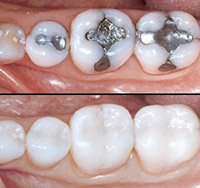More conservative than a crown, inlays and onlays are two methods of restoring normal tooth structure after decay or other damage.
Inlays and onlays are known as indirect fillings because unlike a standard filling that is done ina dentist'soffice, both are made in a laboratory and cemented or bonded to the surface of the tooth during a second visit to the dentist. And unlike standard fillings, inlays and onlays do not weaken the tooth structure, but actually strengthens it. After theprocedure the tooth can bear up to 50 - 75% more chewing force.
 An inlay is done when the tooth structure replaced is within the cusp tips of thetooth. If the damage is more extensive and the newstructure covers the entire chewing surface including one or more tooth cusps, the procedureis called an onlay. What are the most common benefits of this procedure? An inlay is done when the tooth structure replaced is within the cusp tips of thetooth. If the damage is more extensive and the newstructure covers the entire chewing surface including one or more tooth cusps, the procedureis called an onlay. What are the most common benefits of this procedure?
Inlays and onlays are ways of repairing relatively extensive tooth decay or damage without having to replace the whole outer portion of the tooth as with acrown. Less tooth material is removed so inlays and onlays tend to be more conservative and esthetic than crowns. Unlike fillings, these procedures strengthen a tooth's structure. They also tend to last longer than a filling, because the inlay or onlay material is custom made and bonded to the tooth.
What will happen at the initial consultation?
At the initial consultation the dentist will determine whether the tooth can be repaired using an inlay or onlay procedure or whether a more extensive treatment, such as a crown, is needed. Once it is determined that an inlay or onlay will suffice, a decision needs to be made as to the material. Gold has the longest track record, but it does tend to be less esthetically appealing. Porcelain and tooth colored composite resin are two other choices of material for the new tooth structure. Because both of these materials are tooth colored they are particularly favored if the tooth is visible or if esthetic results are an important goal. However, porcelain or composite resin may be more expensive than gold and these materials have been usedfor less time for this purpose, so their track record for longevity is less known.
How is the procedure performed?
Inlays and onlays are performed using very similar procedures. Both require two trips to the dentist. At the first appointment, the dentist begins the procedure by numbing the area using a local anesthetic. The decay or damage is removed using a drill, preparing the tooth for its new surface. After all the damage is removed, an impression is made of the prepared tooth so the inlay or onlay Inlays - Onlaysmaterial can be cast in a  form that will fit the tooth exactly. A temporaryrestoration is placed on the tooth to protect it until the laboratory makes the new structure and it can be bonded to the tooth. This can take about two to three weeks. Using theimpression, a laboratory prepares the new tooth surface using gold, porcelain or composite resin. Upon return to the dentist's office, the temporary restoration is removed and the surface is cleaned to prepare for the new structure. The dentist will then try in the new restoration to ensure that there is a correct fit that doesn't interfere with your bite. If the fit is good, using special cement or bonding, the inlay or onlay is permanently attached to the tooth. Some minor adjustment may need to be made to the restoration if there are interferences. To finish the procedure, the dentist will polish the cemented or bonded structure and tooth. form that will fit the tooth exactly. A temporaryrestoration is placed on the tooth to protect it until the laboratory makes the new structure and it can be bonded to the tooth. This can take about two to three weeks. Using theimpression, a laboratory prepares the new tooth surface using gold, porcelain or composite resin. Upon return to the dentist's office, the temporary restoration is removed and the surface is cleaned to prepare for the new structure. The dentist will then try in the new restoration to ensure that there is a correct fit that doesn't interfere with your bite. If the fit is good, using special cement or bonding, the inlay or onlay is permanently attached to the tooth. Some minor adjustment may need to be made to the restoration if there are interferences. To finish the procedure, the dentist will polish the cemented or bonded structure and tooth.
How long does the procedure take?
Generally, each visit will take about one hour, although the first appointment tends to be longer with an onlay as more tooth structure is removed.
Where will the procedure be performed?
The procedure is performed during two visits to the dentist's office.
How much pain is there?
Local anesthesia takes care of the pain that would occur with the preparation of the tooth. Residual pain after the preparation or after cementing the structure in place is relatively rare, and can usually be taken care of using over-the-counter medicines such as aspirin or acetaminophen.
What can I expect after the procedure?
After the procedure there may be a little discomfort with the inlay or onlay, but many people adapt immediately to the new chewing surfaces. Sometimes the tissue around the work is sore or the tooth is temporarily sensitive to cold or hot foods. These minor problems should resolve themselves in one or two days.
What is the recovery period like?
Recovery is often immediate, with any discomfort taken care of using over-the-counter medicines.
What is the long-term outcome like for most people?
Gold inlays and onlays will last 10-30 years, given proper care and avoidance of abuse. Although the structures do strengthen the teeth, it is still a good idea to avoid chewing ice, pits, or other very hard objects, as they could damage the work.
Ideal Candidate:
The ideal candidate will have too much damage or decay to be treated using a filling, but enough healthy tooth left that a crown is unnecessary.
Other important information:
Note also that two visits to the dentist for an inlay or onlay, now generally necessity, may soon be a thing of the past. A new computer generated system has been developed that takes the impression and makes the inlay or onlay all in one step. This allows the preparation and bonding steps to be performed in one appointment.
Risks and Limitations:
The number of risks for inlays and onlays are very small. Many restoration procedures typically require local anesthesia and some people may have allergic reactions to the medication. Also, a very small number of people are allergic to one or more of the metals used in the inlay or onlay. In most cases, the dentist can use another material.
Choosing a dentist
Most general dentist can provide this service. You may need to find one that specializes in cosmetic procedures to have a full choice of materials. Asking how many of these procedures the dentist has done, what type of materials are available and whether you can speak with a patient who had undergone the procedure can help narrow the field.
|